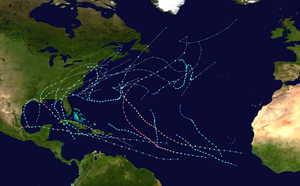| 2021 Atlantic hurricane season | |
|---|---|
 Season summary map | |
| Seasonal boundaries | |
| First system formed | May 22, 2021 |
| Last system dissipated | November 7, 2021 |
| Strongest storm | |
| Name | Sam |
| • Maximum winds | 155 mph (250 km/h) (1-minute sustained) |
| • Lowest pressure | 927 mbar (hPa; 27.37 inHg) |
| Seasonal statistics | |
| Total depressions | 21 |
| Total storms | 21 |
| Hurricanes | 7 |
| Major hurricanes (Cat. 3+) | 4 |
| Total fatalities | 197 total |
| Total damage | $80.827 billion (2021 USD) (Fifth-costliest tropical cyclone season on record) |
| Related articles | |
The 2021 Atlantic hurricane season was the third-most active Atlantic hurricane season on record in terms of number of tropical cyclones, although many of them were weak and short-lived. With 21 named storms forming, it became the second season in a row and third overall in which the designated 21-name list of storm names was exhausted. Seven of those storms strengthened into a hurricane, four of which reached major hurricane intensity,[nb 1] which is slightly above-average. The season officially began on June 1 and ended on November 30. These dates historically describe the period in each year when most Atlantic tropical cyclones form.[2] However, subtropical or tropical cyclogenesis is possible at any time of the year, as demonstrated by the development of Tropical Storm Ana on May 22, making this the seventh consecutive year in which a storm developed outside of the official season.[nb 2][3]
Three named storms formed in June, tying the record for the most to develop in that month. Among them was Tropical Storm Claudette, which brought flooding to portions of the Deep South. Then, on July 1, Elsa developed and became the earliest-forming fifth named storm on record surpassing Tropical Storm Edouard in 2020. The storm later caused significant impacts from Barbados to much of the East Coast of the United States, with about $1.2 billion in damage in the latter region.[nb 3] In August, Tropical Storm Fred flooded parts of the Caribbean and Southeastern United States, resulting in roughly $1.3 billion in damage. Hurricane Grace intensified to a Category 3 major hurricane before making landfall in the Mexican state of Veracruz, causing 17 deaths and about $513 million in damage in the Greater Antilles and Mexico. On August 22, Henri struck Rhode Island and brought flooding and high winds to the Northeastern United States, with damage estimated at $700 million.
Hurricane Ida became the deadliest and most destructive tropical cyclone of the season after striking southeastern Louisiana at Category 4 strength in late August, 16 years to the day after Hurricane Katrina decimated that same region. After devastating Louisiana and moving farther inland, Ida caused catastrophic flooding and spawned several destructive tornadoes across the Northeastern United States. Damage estimates from the storm exceeded $75 billion, contributing to over 93% of the total damage done in 2021 season. Additionally, Ida killed 107 people, directly or indirectly, throughout the impacted regions. In September, Hurricane Larry peaked as a powerful Category 3 hurricane over the open Atlantic before making landfall in the Canadian province of Newfoundland and Labrador as a Category 1 hurricane. Later in the month, Hurricane Nicholas moved erratically both on- and offshore the coasts of Texas and Louisiana. Freshwater flooding, coastal flooding, and winds generated by Nicholas left about $1 billion in damage. Hurricane Sam became the most intense system of the season, peaking as a strong Category 4 hurricane in late September. Tropical cyclones during this season collectively caused 194 deaths and nearly $81 billion in damage, making it one of the costliest Atlantic hurricane seasons on record.
Nearly all forecasting agencies predicted above-average activity during the season, due to expectations of abnormally warm sea surface temperatures, the unlikelihood of an El Niño, and the possibility of a La Niña. Although these forecasted conditions transpired during the season, the agencies slightly underestimated the number of named storms, but nearly all were fairly accurate with the number of hurricanes and major hurricanes. This season, the National Hurricane Center (NHC) began issuing regular Tropical Weather Outlooks on May 15, two weeks earlier than it has done in the past. The change was implemented given that named systems had formed in the Atlantic Ocean prior to the start of the season in each of the preceding six cycles.[4] Prior to the start of the season, NOAA deployed five modified hurricane-class saildrones at key locations around the basin, and in September, one of the vessels was in position to obtain video and data from inside Hurricane Sam. It was the first-ever research vessel to venture inside the middle of a major hurricane.
- ^ Cite error: The named reference
Backgroundwas invoked but never defined (see the help page). - ^ "Hurricane Season Information". Frequently Asked Questions About Hurricanes. Miami, Florida: NOAA Atlantic Oceanographic and Meteorological Laboratory. June 1, 2018. Archived from the original on September 17, 2021. Retrieved April 13, 2021.
- ^ a b Forbes, Alex (June 1, 2022). "No Atlantic storms develop before hurricane season for first time in seven years". Macon, Georgia: WMAZ-TV. Archived from the original on January 28, 2024. Retrieved August 12, 2022.
- ^ Allen, Greg (February 26, 2021). "Hurricane Forecasts Will Start Earlier In 2021". NPR. Archived from the original on May 14, 2021. Retrieved February 27, 2021.
Cite error: There are <ref group=nb> tags on this page, but the references will not show without a {{reflist|group=nb}} template (see the help page).